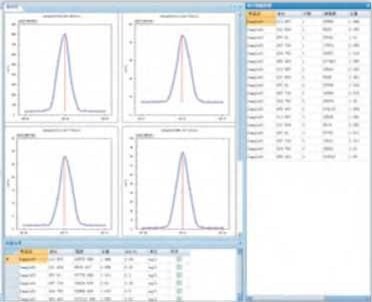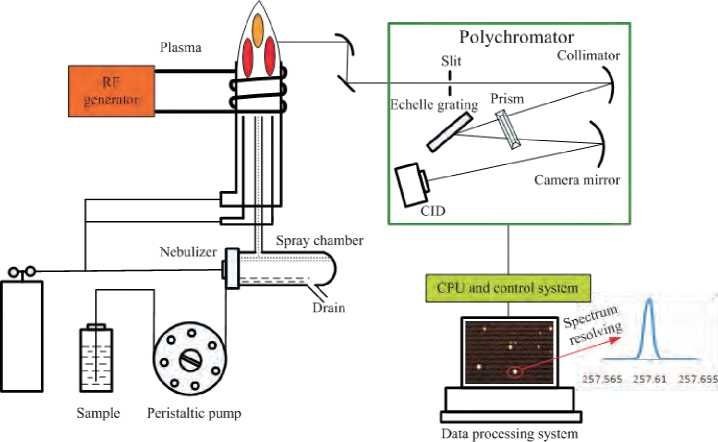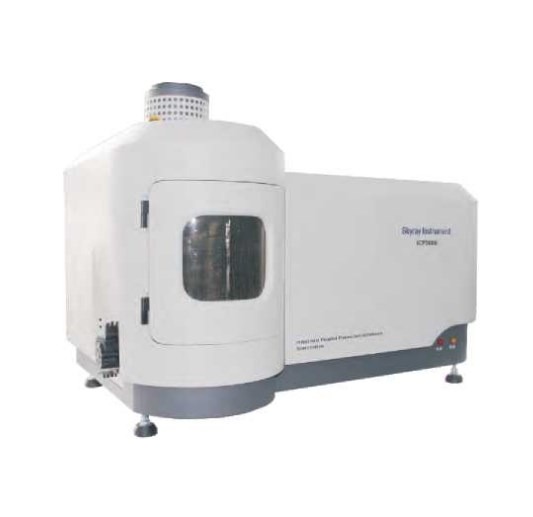DW-ICP-OES3000 Inductively Coupled Plasma Optical Emission Spectrometer
DW-ICP-OES3000 inductively coupled plasma emission spectrometer is a powerful performance, simultaneous full-spectrum direct- reading spectrometer developed by Drawell, which is used for trace elemental analysis in diverse samples (soluble in hydrochloric acid, nitric acid, hydrofluoric acid. etc). The instrument offers capabilities with automatization, stability, reliability, and ease of use. It is currently widely applied in various fields of rare earth, geological, metallurgical, chemical, environmental, clinical medicine, petroleum, semiconductor, food, biological samples, criminal science, agricultural research, etc…
Application Fields
- Silicon Industrial: magnetic materials
- Metallurgical: analyze As, Bi, Pb, Sb, Sn, and other impurity elements, which affect greatly the quality of the metallic materials
- Water analysis: analyze 8 heavy metal elements
- Geological, minera: analyze Ca, Mg, Na, Fe, Cu, Mn, Zn, Co, Ni, Au, Ag, and other elements in the rock samples
- Petrochemical and Industrial: Analyze over 30 elements in crude oil, mainly Fe, Na, Mg, Ni, V, Ca, Pb, Mo, Mn, Cr, Co, Ba, As, etc.
- Pharmaceutical, health, agricultural and environmental and Food Safety.
Advantages
Full automation design
The instrument is thoroughly computer-controlled except for the power switch, which is reliable, safe, and convenient.
Auto-control of gas flow
In the sample introduction system, the carrier gas, plasma gas, auxiliary gas are controlled through the advanced mass flow controller (MFC), features continuously adjustable and stable, etc., which ensures the stability of the introduction system and the foundation for the stable light source.
Peristaltic pump
A high precision 12 roller, 4 channel peristaltic pump, with speed adjustable according to the demanding, provides smooth, stable sample introduction and drain, to ensure the introduction rate consistent with the drain rate, which is adjusted as per required to stabilize the introduction system.
Precise wavelength positioning
Intelligent, precise automatic wavelength calibration algorithm, achieves the measurement without additional peaks calibration, to ensure an accurate measurement whilst saving solution and measurement time.

Fast, accurate auto-matching
The load terminals employs the full-automatic matching technology developed by Drawell, features fast matching, high precision, etc., which could achieve maximum output power, enhance power efficiency, ensure the stability of the instrument whilst facilitating ignition.
Stable, advanced solid-state RF power
The instrument employs the solid-state RF power developed by Drwell, which is compact and delivers reliable performance with the power stability and safety, to further improve the instrument’s stability and security.
Ultra-fast analysis speed
The analyst can set any suitable integration time for all the analytical lines in one exposure to achieve optimal measurement, or acquire the intensity integral value in the end of the exposure to enable the analysis faster, or specify any one or several specific line(s)to read-out(the readout time<2ms).
Superb optical system
Adopting the echelle-prism cross-dispersion type polychromator, elegant optical optimization design maximizes the flux whilst enabling the excellent spectral resolution. No movable optical components achieves unparalleled long-term stability; Ultra-low stray light design with the unique optical design greatly reduces the background interference and further improves the detection limit. A highly efficient N2 distributed purge system for the optical tank combined with the high-quality optics ensures deep UV analysis, especially P, S, As, etc..
Powerful software analysis function
Software is easy to operate and intuitive, it offers the capability with qualitative, semi-quantitative and quantitative analysis, instrument diagnostics, intelligent optimization, flexible full-spectrum research function, strong offline reprocessing, scientifically intelligence background correction and interference cancellation algorithm, which enable the analysis more professional and accurate.
Excellent performance detector
Employing the CID detector, which is advanced, mature and stable, largest-size active area, megapixel. Full-frame Imaging ability to capture the entire ICP-OES spectrum (165-900 nm) permits quantitative analysis. Non-destructive readout improves the signal-to-noise ratio of weak analyte lines and ensures the precision of results, whist enabling data acquirement and analysis faster than CCD. Excellent linear dynamic range and inherent anti blooming capability allow the measurement of weak analyte emission signals adjacent to intense emission signals, whilst providing flexibility to choose the ideal wavelength for a method (alternative secondary and tertiary lines to overcome interferences).
Advanced sample introduction system
The sample introduction system is efficient and stable, equipped with various nebulizers and spray chambers, it can also be equipped with high solids nebulizer, hydrogen fluoride-resistant nebulizer, etc.as per required. Besides, the autosampler developed by Drwell facilitates the operation, and further improves the analysis efficiency.
Technical parameters
RF Generator Technical Specifications
| Input Power | AC 220V, 20A |
| Output power | 700-1600W |
| Accuracy | 2W |
| Working Frequency | 27.12MHz |
| Frequency stability | <0.05% |
| Output power stability | <0.1% |
| Match method | auto-matching |
| Electromagnetic leakage radiation intensity | electric field intensity E <0.5V / m at 30cm away from the chamber |
Introduction Sample system Technical Specifications
| Output coil | Inner-diameter 25mm, 3 turns |
| Quartz tri-concentric torch | Outer-diameter 20mm. Various center channel size models optional |
| High-efficient nebulizer | Concentric nebulizer outer-diameter 6mm. Vvarious models ( high-salt,anti-HF, etc.)optional |
| Spray chamber | Scott spray chamber, the cyclonic spray chamber with outer diameter 57.2mm optional |
| Peristaltic pump | 12-roller, 4-channel, the rotation speed can be adjusted according to the demanded flow |
| Total consumption(Ar) | <14L/min |
| Plasma gas flow meter (100-1000)L/h (1.6-16L/min) | |
| Argon flow meter/carrier | Auxiliary gas flow meter(6-60)L/h (0.1-1 L/min) |
| Gas pressure gauge | Carrier gas flow meter(6-60)L/h (0.1-1 L/min) |
| Specifications | Carrier gas regulator valve (0.2MPa) |
| Cooling water: Water temp. 20-25″C Flow> 5L/min Pressure> 0.1MPa |
Spectrometer Specifications
| Ruled echelle grating | 52.67 Ip/mm, 64°blaze angle, the substrate is made of the Zerodur® produced by German SCHOTT, features near-zero thermal expansion coefficient , enabling outstanding performance |
| Prism | Ultra-pure Corning UV fused silica, transmittance 99.6% at 170nm. |
| Wavelength range | 175nm-900nm for standard, extended to 165nm-900nm by choosing DUV optical components |
| Effective Focal length | 430mm |
| Numerical aperture | F/8, ultra-high flux ensures the instrument detection limit and sensitivity |
| Resolution | 0.0068nm@200nm |
| Stray light | Equivalent background concentration of 10000ppmCa solution <2ppm at As189.042nm |
| Optical chamber | Precisely thermostat, 35±0.1*C |
| Distributed N2 purge: normal purge 2L/min, fast purge 4L/min |
Detection Device Technical Specifications
| Detector Type | Charge injection detector (CID) |
| Pixel Size | 27 x27 pm,Random Access Integration (RAI) |
| Read mode | Full frame readout (FF), Random Access Integration (RAI) with non-destructive read (NDRO) |
| Linear dynamic range | 108 |
| Wavelength response range | 165nm-1000nm |
| Electronic shutter | Set the integration time of each line; specify the individual line to read out(read time <2ms) |
| Quantum efficiency | No coating, up to 35% within 200nm UV region |
| Detector cooling | High efficiency triple stage thermoelectric cooling device maintains the detector at a constant-45 °C |
Instrument Specifications
|
View mode |
Radial view |
|
Liquid content |
0.01 ppm- several thousands ppm |
|
Solid content |
0.001%—70% |
|
Repeatability |
(short-term stability) relative standard deviation RSD <0.5% |
|
Stability |
Relative standard deviation RSD <1 % within 2 Hours |
|
Analysis speed |
Single line CID readout time is 2ms, analysis for all elements can be achieved within one minute |
|
Detection limit (pg/L) |
1 ppb-10ppb for most elements |
|
Instrument size |
Desktop 1300mm*840mm*740mm |
The typical detection limit of elements
|
Element |
Ag |
Ba |
Be |
Ca |
Cr |
Cu |
K |
Li |
Mg |
|
Wavelength |
328.068 |
455.403 |
311.107 |
393.366 |
267.716 |
324.754 |
766.49 |
670.784 |
279.553 |
|
Detection limit |
1.31 |
0.1 |
0.06 |
0.02 |
1.3 |
1.1 |
4.9 |
0.2 |
0.05 |
|
Element |
Mn |
Mo |
Na |
Ni |
Sr |
Ti |
V |
Zn |
|
|
Wavelength |
257.61 |
202.03 |
589.592 |
231.604 |
407.771 |
336.121 |
309.311 |
213.856 |
|
|
Detection limit |
0.22 |
1.11 |
1.43 |
2.19 |
0.034 |
0.42 |
0.88 |
0.47 |
| Instrument Configuration | Working Environment | ||
| Fully automated matcher | Manual | Store&transport temp.:15°C-25*C | Power adaptability: |
| The sample introduction system | Detection device | Store&transport relative humidity:<70% | 220±10V, |
| Fully automated solid-state RF power | Spectrometer | Working humidity: <70% | 50-60HZ |
| Auto-controlled cooling water apparatus | Computer system | Working temp.: 15,C-30Q | |
Software advantages
ICP-3000 Software:
ICP3000 operating software can control all functions of the instrument, including plasma ignition, gas flow control (Figure 1), and security monitoring (Figure 2), etc…


Daily Analysis Software:
specifying the individual pixel or pixel subarray region for quantitative analysis (Figure 3 & 4).


Methods & data set separation management, strong off-line re-processing function, auto or manual real-time background correction for option(Figure 5)

Fullframe-spectrum mode:
directly showing the whole emission spectra, directly acquiring the emission intensity, auto-peak identification, interactive spectral library, qualitative&semi-quantitative analysis of the elements (Figures 6, 7 and 8):



Autosampler mode:the autosampler is provided as per required.
Calibration type:multi-point calibration curve, of which the number of the standard points is not limited.
Curve fitting display: linear, auto-adjust the range.
Data report:export the report based on sample names, method names, elements, intensity, concentration, mean, standard deviation, relative standard deviation, time, date, etc., and generate the analysis report automatically.
Optional format:analysis data can be stored in user-specified data format, e. g. Excel, Word, PDF, image, etc..
Instrument structure diagram:




